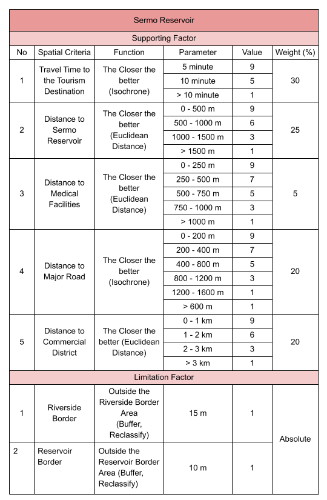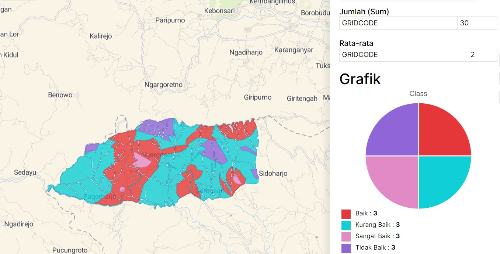Abstract
Have you ever wondered how big the impact of infrastructure and facilities development in such a suburban area can do on tourism development? This publication analyzes the phenomenon of this issue in Kulon Progo, where the expansion of Yogyakarta International Airport (YIA) affects and invigorates the growth of the Kulon Progo Tourism Scheme. The analysis focuses on how the hotspot tourism area will grow due to the impact of YIA. Furthermore, this publication takes a deeper look at how tourism affects the growth of local accommodation demand through spatial analysis.

Between Kulon Progo, Tourism, and Yogyakarta International Airport (YIA)
D.I. Yogyakarta (DIY) has become one of the most popular tourist destinations, attracting domestic and international tourists. DIY is recorded as one of the strategic areas for national tourism with various attractions, from nature and culture to culinary tourism.
Kulon Progo Regency is one of the areas in DIY that has a lot of tourist attractions. Kulon Progo Regency has various kinds of resource wealth, especially in the availability of natural resources, so it has the potential for generating tourism activities. This wealth of natural resources is supported by the tropical climate and geographical conditions of Kulon Progo Regency, which has mountains and beaches, so it becomes an added value for the Kulon Progo tourism sector.
Sadly, with the many potential natural tourist points in Kulon Progo Regency, there are still several tourist points that have yet to receive the attention of tourists. This is due to the lack of intervention from both the government and the private sector. This is an urgent problem for the government, considering that it is one of the pillars of regional development that is very important in revenue, regional development, and absorption of investment and labor in Kulon Progo. Following Government Regulation Number 50 of 2011 concerning the Master Plan for National Tourism Development (Ripparnas), Kulon Progo Regency is part of the National Tourism Strategic Area (KSPN).
The construction of Yogyakarta International Airport (YIA) is one of the government's efforts to support efforts to develop the tourism sector in DIY. This will undoubtedly impact the development of tourist destinations in Kulon Progo Regency for the next few years. The increase in the number of tourists who come to Kulon Progo and the infrastructure development triggered by the YIA area development plan are the two main factors that can underlie the effect of tourist destinations in Kulon Progo.
This trend of tourism development will, of course, also benefit several parties, such as tourists, tourism managers, private investors, and the government in the tourism sector, if they can take advantage of opportunities well. Therefore, it is necessary to project the development of tourism in Kulon Progo Regency to provide recommendations for each party to be able to see more clearly the direction of development of tourist destinations and tourism potential points after being hampered by the tremendous impact of the development of the Yogyakarta International Airport (YIA) airport area in Kulon Progo Regency.
How would this publication help tourism industry?
This publication is intended to analyze the development of tourist destinations in Kulon Progo after the construction of Yogyakarta International Airport (YIA). In more detail, the analysis contains points of tourist destinations that have the most significant potential for development after being affected by the construction of YIA Airport, recommendations for several parties in the intervention steps to respond to these tourism development opportunities such as the private sector, tourism managers, tourists, and the government. There is also an explanation of the mapping of potential location points in the procurement of lodging facilities that can be used by the private sector to make it easier to choose potential locations to invest in hotel development as a tourism facility.
How the analysis goes���
This research phase is divided into two stages. Starting with an analysis of natural tourist destinations in Kulon Progo, then from each existing point, the researchers conducted a study of each current destination point by using the 4A factor (amenity, accessibility, attraction, ancillary) as a ballast point of analysis. The above factors are further divided into several derivative factors such as:
- Types of attractions
- Road access
- Tourist amenity
- Main road proximity
- Visitor Count
- Ancillary
- Government Planning Document
- Distance to Yogyakarta International Airport (YIA)
Each of these factors is going to be used in the filtration process to narrow every destination point in Kulon Progo to only 3 potential destination points that have a vast growth potential in several years. Furthermore, from these 3 potential destination points or so we called "hotspot," we are going to analyze deeper, which resulted in the recommendation of potential sites for lodging facilities (hotel, homestay, resort, guesthouse).
After the filtration process, the 3 hotspots we mentioned belong to Kulon Progo's south coastal area, the Menoreh hills area, and the Sermo reservoir area. These 3 areas were selected by measuring its growth potential for the next several years.
Hold on, it's getting serious.
By this segment, we are starting to deliver the technical way of the spatial analysis method and data we use to analyze the topics. The criteria mentioned were then scored based on the assumptions in which each area has its own segmentations; coasts, hills, and man-made tourism. Spatial analysis methods, including isochrone, buffer, reclassify, and limitations which will be explained briefly.
Isochrone is defined as a line drawn on a map connecting points at which something occurs or arrives at the same time. This method depicts the area accessible from a point within a certain time threshold, usually used in transportation planning.
Buffer analysis determines a zone around a geographic feature containing locations within a specific distance of that feature. It is used for identifying areas surrounding geographic features and is a commonly used tool within proximity analysis methods.
Reclassification is reassigning one or more values in a raster dataset to new output values. Simply put, this method involves replacing individual values with new ones. The tools are designed to allow you to easily change many values to desired, specified, or alternative values.
Limitation is a substantial method in which specific areas need to be excluded due to protected areas.
All these Methods showed in the Spatial Criteria tables below.



Too Much Talking, Here’s the Result

After long boring data and method preparation you've seen before, the process continue with overlaying all the data collections with different range of weights based on the data above, resulting areas in which are categorized as very suitable, suitable, not quite suitable, and not suitable for tourism accommodation development.
We separate the overlaying process for each three "hotspot" areas we mentioned before. Thus, there will be 3 results that show you the categorized potential area for tourism accommodation (lodging) development. These three results will stand for the Menoreh hills area, Kulon Progo south coastal area, and Sermo reservoir area.
Kulon Progo South Coastal Area


The coastal area consists of many different beaches, including Congo Beach, Glagah Beach, Bugel Beach, and Trisik Beach, with a total area of around 347 Ha. Some of the beaches in the area are included in the Top 10 Tourist Destinations in Kulon Progo. The distance between the beaches and YIA is approximately 10 - 20 kilometers, with easy accessibility. The Local Government of Kulon Progo is aware of these potentials and has mentioned several strategies for tourism development in this area.
The result shows us that the most suitable area is located in the middle of the region. These areas become the most suitable ones because they have the most flexible accessibilities among the others. The accessibilities mean that the area is near the major road and the attraction point.
Sermo Reservoir Area


Sermo Reservoir (Waduk Sermo) is the only reservoir in DIY built in 1996 with an area of 157 Ha. Apart from its irrigation purposes, this artificial lake has become one of the favorite tourist attractions in Jogja, the pride of Kulon Progo. It is located in Hargowilis Village, Kulon Progo Regency, a tourist village offering many potential destinations for tourists to enjoy nature, culture, and gastronomy. In the future, there will be Astro-tourism. Due to its status as a tourist village, we then determine the area of observation within the administrative limit of Hargowilis Village.
Areas around the reservoir are very suitable since it is surrounded by hills which offer different viewpoints of Sermo Reservoir from a height. It is also an area that provides camping grounds and other outdoor tourism activities. The suitable area also consists of potential tourist destinations of hills, which have easy accessibility to different types of amenities. Furthermore, some areas are not quite suitable, since although it also has tourist destinations but doesn't have good enough accessibility to amenities and main roads.
Menoreh Hills Area


Located on the border between Kulon Progo Regency and Magelang Regency, this area has a mountainous landscape because it stands alongside Menoreh Mountain Area. This observation area consists of many tourist villages and nature tourism, such as hills, tea gardens, and beautiful boulder rocks. In the future, accessibility would be easier to the area through YIA since the government has toll road construction plans to Borobudur.
The most suitable areas are around the top of the hill. This is because many tourists take advantage of hill views, so besides being close to tourism, this area also offers beautiful views of the Menoreh Mountains. On the contrary, areas that are not recommended are located in areas that rarely have tourism, and the scenery tends to be less good.
Writer:
Damar Kusumo Syahputro, Haniyfa Azalea Satriya, Muhammad Fikri Hidayat, Surof Abdi Ibadurrahman


![[GEODATA] Tutupan Lahan Indonesia](https://mapidstorage.s3.amazonaws.com/general_image/mapidseeit/1684312961161_COVER%20GEODATA_%20Tutupan%20Lahan.png)
![[GEODATA] Status Ekonomi dan Sosial (SES) Indonesia](https://mapidstorage.s3.amazonaws.com/general_image/mapidseeit/1693454652933_20230831-085941.jpg.jpeg)


![[GEODATA] Kajian Infrastruktur Pariwisata di Banda Neira dan Karimunjawa](https://mapidstorage.s3.ap-southeast-1.amazonaws.com/general_image/mapidseeit/1746757972849_no_name_file.png)



